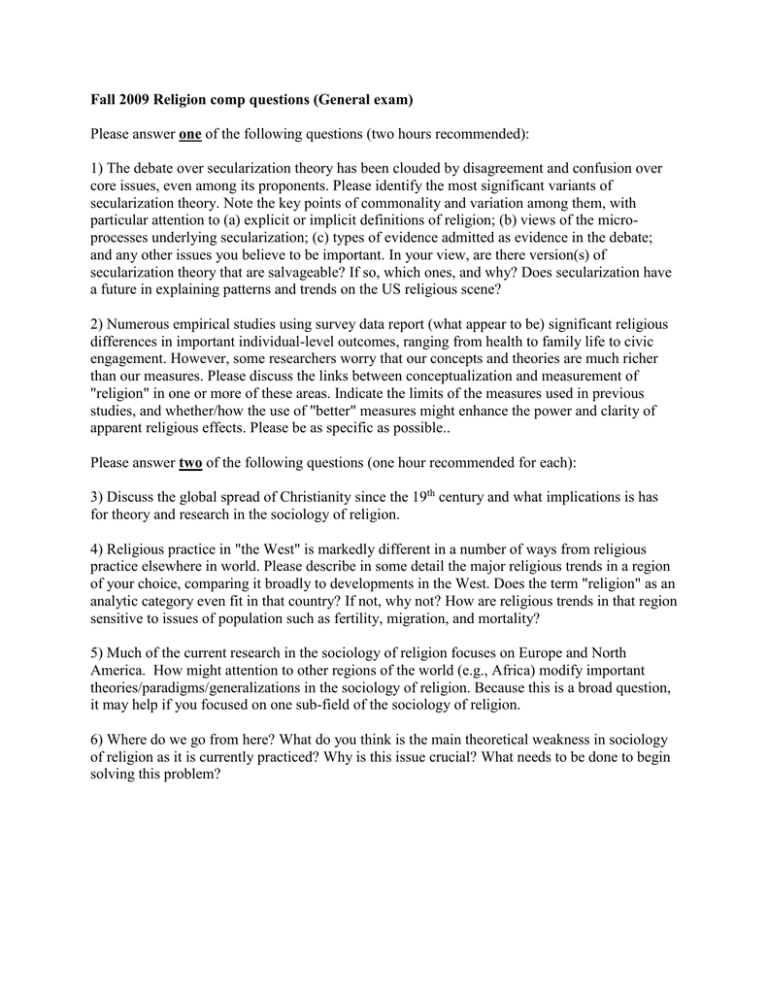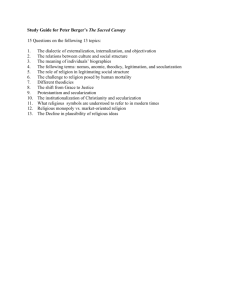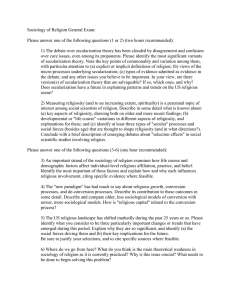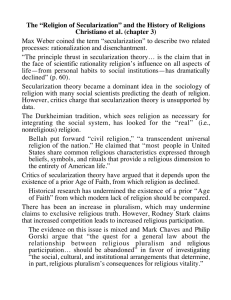Fall 2009 Religion comp questions (General exam) one
advertisement

Fall 2009 Religion comp questions (General exam) Please answer one of the following questions (two hours recommended): 1) The debate over secularization theory has been clouded by disagreement and confusion over core issues, even among its proponents. Please identify the most significant variants of secularization theory. Note the key points of commonality and variation among them, with particular attention to (a) explicit or implicit definitions of religion; (b) views of the microprocesses underlying secularization; (c) types of evidence admitted as evidence in the debate; and any other issues you believe to be important. In your view, are there version(s) of secularization theory that are salvageable? If so, which ones, and why? Does secularization have a future in explaining patterns and trends on the US religious scene? 2) Numerous empirical studies using survey data report (what appear to be) significant religious differences in important individual-level outcomes, ranging from health to family life to civic engagement. However, some researchers worry that our concepts and theories are much richer than our measures. Please discuss the links between conceptualization and measurement of "religion" in one or more of these areas. Indicate the limits of the measures used in previous studies, and whether/how the use of "better" measures might enhance the power and clarity of apparent religious effects. Please be as specific as possible.. Please answer two of the following questions (one hour recommended for each): 3) Discuss the global spread of Christianity since the 19th century and what implications is has for theory and research in the sociology of religion. 4) Religious practice in "the West" is markedly different in a number of ways from religious practice elsewhere in world. Please describe in some detail the major religious trends in a region of your choice, comparing it broadly to developments in the West. Does the term "religion" as an analytic category even fit in that country? If not, why not? How are religious trends in that region sensitive to issues of population such as fertility, migration, and mortality? 5) Much of the current research in the sociology of religion focuses on Europe and North America. How might attention to other regions of the world (e.g., Africa) modify important theories/paradigms/generalizations in the sociology of religion. Because this is a broad question, it may help if you focused on one sub-field of the sociology of religion. 6) Where do we go from here? What do you think is the main theoretical weakness in sociology of religion as it is currently practiced? Why is this issue crucial? What needs to be done to begin solving this problem? 7) In your view, what are the three (3) most important, far-reaching trends in religious, affiliation, practice and belief among the American public? What are their implications for the ways in which religion will be lived and practiced in the US over the next 30-40 years, and why? Finally, please offer your most persuasive and nuanced explanations for each of these trends, and indicate how a better understanding of each will advance the sociology of religion. (Points will be deducted for any use of the term "intersectionality.") 8) For decades, one daunting problem in the social scientific study of religion was the absence of any overarching theoretical perspective aside from secularization. Beginning in the late 1980s, rational choice theory has filled that gap for many prominent social scientists. Please outline the key features of the rational choice approach, noting the multi-level (i.e., micro-, mezzo- and macro-level) nature of this approach as developed by Iannaccone, Finke, and Stark. What is your view of the strengths and weaknesses of the micro-level rational choice perspective? How does it illuminate or obscure key features of individual religious life? Please be specific.



